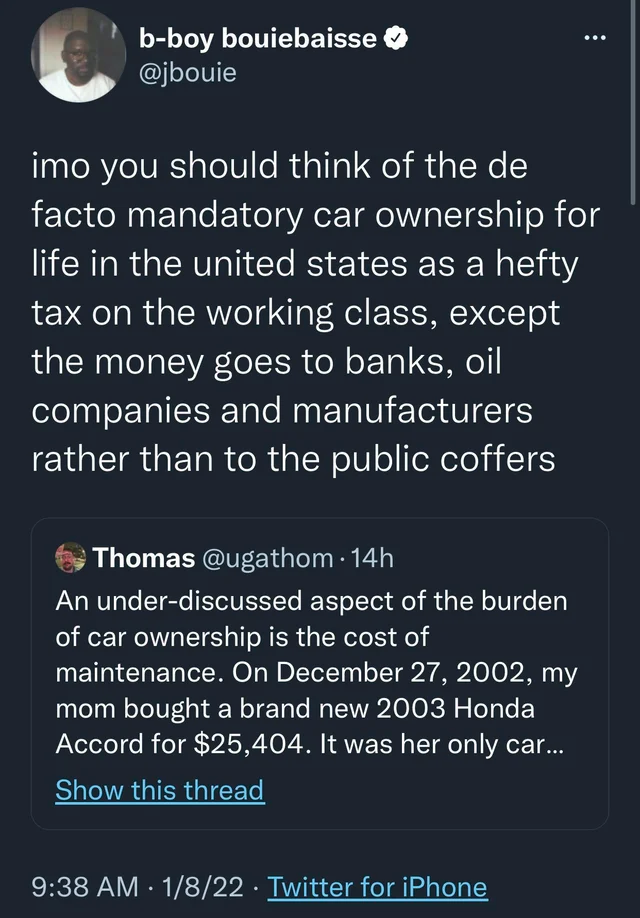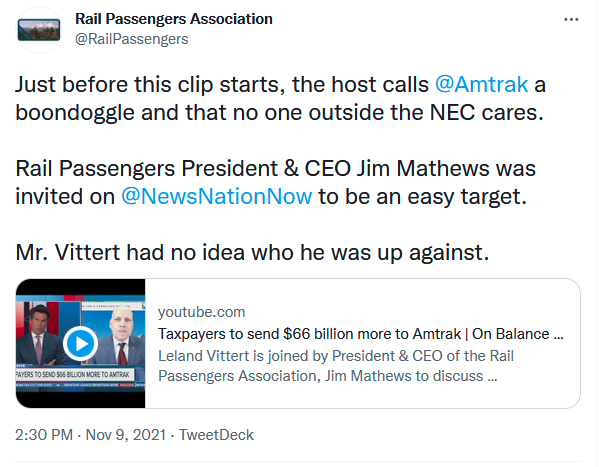Everything posted by gildone
-
Ohio Intercity Rail (3C+D Line, etc)
I'll take whatever, but since states are supposed to lead.... if Ohio is smart, they will follow what the late former ORDC Commissioner Jim Seney's approach. His approach was to assume the host railroads would be paid market value for track access instead of Amtrak's discounted statutory rate and put operations out for bid, and I believe the state was going to be in charge of the equipment as well. It's what California does. They just use Amtrak to run the trains. However, we are in a different world now in one key respect, and how the state of Virginia is doing things with CSX illustrates it: it is the expectation of the host railroads that excess right-of-way width is purchased or leased from them for the construction of separate tracks for passenger operations. I actually agree with the approach. Obviously, it gets rid of the freight interference problem, but if the host railroads don't own the separate tracks, they really can't object to other operators besides Amtrak using them. That puts the states in a much easier position to use competitive bidding for operations. If anything can make Amtrak more transparent and offer better service, competitive bidding would.
-
Ohio Intercity Rail (3C+D Line, etc)
Two State Reps. have introduced a Resolution of Support in the Ohio General Assembly in support of the Amtrak "Connects Us" plan. They have 10 co-sponsors including one GOP member of the House and are seeking more to advance the resolution for hearings and a vote. Here is a link to their press release: https://ohiohouse.gov/members/adam-c-miller/news/rep-sheehy-miller-call-on-ohio-to-invest-in-passenger-rail-108418?fbclid=IwAR36FsiL2AyGcvBjVrqpTiqQ_73kg6Z4PbS9qLvVA_t6BffdGoka7xPj93c
-
Rethinking Transport in the USA
I discovered another great podcast: It's called Active Towns. Cleveland's own Angie Schmitt was on the podcast in October 2020. It should be available on most podcast apps. https://activetowns.transistor.fm/
-
Rethinking Transport in the USA
- Cycling Advocacy
I'm not a hardcore rider, but I've done 20- and 30-mile rides. I modified my classic hybrid bike years ago to be a lot more upright. I didn't notice very much difference at all in how tired I get on long rides. Putting my upper body weight on my hands, which pushed down into the handlebars, I've always found to be very uncomfortable after a few miles and more tiring than sitting upright. I've tried several different types of "cushioned" grips, and nothing makes it any different. Yes, the wind blows you around a bit more, but I can still duck when going downhill, etc. I want to do some long-distance, multi-day cycling trips in the future on recreational trails. I already know that there is no way I could stand being bent over all day long. I can see the use of a bike with a typical American sporty, bent-over design for hardcore riders who do it for sport. I don't see it as a necessity for everyday use getting around town or recreational trips (even long distance ones). Long story short, it's really just a lot of personal preference.- Greater Cleveland RTA News & Discussion
I tried to file a complaint with the FTA about this because FTA money was used for the project and the project was supposed to include signal prioritization. I never got a response. I even sought help getting FTA to respond from Marcy Kaptur's office. Even they couldn't nudge them.- Greater Cleveland RTA News & Discussion
I thought it existed, but it was never activated.- Greater Cleveland RTA News & Discussion
It's about time. After all, it has only been what, 13 years (2008) since Health Line was completed?- General: Complete Streets, Road Diets, and Traffic Calming
How to Quickly Build a Cycling City - Paris:- Youngstown-Warren: Random Development and News
Big improvement. A protected bikeway along here would be nice. There appears to be room.- Chicago-Atlanta passenger rail
With the proposed Midwest rail corridors and the proposal for rail corridors radiating out of Atlanta, if all are built, that would create a route with capacity for passenger trains from Chicago to Florida. Unfortunately, when this was pointed out to Amtrak a meeting in recent weeks, Amtrak's reply was that they are only interested in routes that allow them to seek financial support from state governments. Long story short: Amtrak would, if these corridors are built, have people change trains 3 times to get from Chicago to Florida rather than provide a one-seat ride. Amtrak's thinking here is as short-sighted as it is ridiculous. Time to re-think the Amtrak model. If these corridors get passenger-only tracks (which is the preference of the host railroads with the state of Virginia as proof-of-concept), then we need to have open access for other passenger rail operators besides Amtrak.- Other Countries: Passenger Rail News
Not Just Bikes always manages to put together a great video. The Trains that Killed an Airline:- Cleveland: Opportunity Corridor Boulevard
I would expect that it will siphon the most traffic between E. 55th and Carnegie. I've never found Carnegie between 71/90 and the Cleveland Clinic to be particularly congested, except perhaps if a heavy snow hits during rush hour.- Cleveland: Opportunity Corridor Boulevard
I always just took I-71/90 to Carnegie and never bothered w/ E.55th. 55th was always too much of a cluster.- Cleveland: Opportunity Corridor Boulevard
Despite the overall tone, the opinion piece actually makes a few decent points. Miring those points down in that overall tone is as unprofessional as it is unnecessary, but Scene often does that to their own detriment. One good point that was implied more than it was discussed directly, is that the road only shaves about 3 minutes off the commute to the Cleveland Clinic. That's over $90 million per minute "saved". That really should never have been an argument for this road. I do hope the OC does bring improvements that actually benefit the people who live in the neighborhood it travels through, but that remains to be seen.- A Road Is A Road To Socialism Road
Driving is a huge entitlement in the US, and motorists want expensive infrastructure as long as someone else foots the bill: https://www-planetizen-com.cdn.ampproject.org/c/s/www.planetizen.com/blogs/115395-roadway-expansion-paradox?amp @GCrites80sspeaking of the private sector screwing up: In a 2014 article in an embedded link in the above called "The Great Traffic Projection Swindle", I didn't know that a well-known consulting firm was the subject of a class-action lawsuit by investors who bought into various tollway privatization projects based on traffic projections provided by the firm that the investors claim were inflated. It appears the lawsuit was settled. https://usa.streetsblog.org/2014/11/20/the-great-traffic-projection-swindle/- General: Complete Streets, Road Diets, and Traffic Calming
I discovered a podcast called: "Car-free Midwest". Here's the trailer: https://www.podbean.com/ea/dir-ei2uj-e1924ee The podcast just started a year ago.- Walkable Communities
In car-dominated Texas, the #1 tourist attraction in the state is the San Antonio Riverwalk. (It is in fact so successful, that other states have taken notice. Oklahoma City built it's own version from scratch in 1999):- Traffic Management (Signals, etc)
Why the Netherlands is the best country for driving:- General: Complete Streets, Road Diets, and Traffic Calming
As we slowly implement real improvements for complete streets and as we continue to make the case for why they are needed... If you ever hear a skeptical planner, engineer or public official say "This isn't the Netherlands", remember this video. The Netherlands wasn't always like it is now. In 1970 the Dutch had a higher rate of traffic deaths (deaths/100,000 population) than the U.S. What we see there today is the result of a 5-decade long, incremental process of re-engineering their roads and streets. .- Amtrak & Federal: Passenger Rail News
Jim Mathews with the Rail Passengers Association hit back at a jackass reporter on News Nation Now (link below image): https://twitter.com/RailPassengers/status/1458154928128634884- Amtrak & Federal: Passenger Rail News
With enough daily frequencies, you can schedule a few trains trains to stop in some of the smaller communities.- Walkable Communities
Our Self-imposed Scarcity of Nice Places https://www.strongtowns.org/journal/2021/11/3/our-self-imposed-scarcity-of-nice-places Every advocate for making urban design more [pick one: walkable, bikeable, beautiful, lovable, inviting, human-scale] has at some point or another faced the charge of elitism. Virtually every feature of public space that makes it more pleasant to linger in, stroll through, or simply view, has at some point been associated by someone with gentrification, or simply culturally coded as upscale. This belief is rooted in the following true observation: The best American examples of top-notch urbanism are mostly places inhabited by well-to-do Americans, and their real-estate prices and rents are usually prohibitive for most others. This includes the majority of places that are currently walkable, bikeable, have attractive human-scale architecture, have attractive greenery, aren't pockmarked with parking lots, and are full of small storefronts suited for local businesses... There is abundant evidence that nearly the entirety of the U.S. and Canada are dramatically under-supplied, not just in quaint historic places, but in walkable urban places, period. It's our “shortage of cities“ that makes urbanism a hot commodity... Scarcity Makes It Harder to Tell What Communities Really Want- Cleveland: Opportunity Corridor Boulevard
I'll give you that.- Cleveland: Opportunity Corridor Boulevard
@TBideonYou aren't alone. Car infrastructure is overbuilt in NE Ohio and indeed the entire country. We have been in the realm of diminishing returns on new road capacity for a very long time. Other types of transportation projects would provide far greater economic returns at this point-- trams, trains, dedicated busways, protected bikeways. These are all under-built and thus have greater potential for economic returns to say nothing about the social returns of having options to the car keys. - Cycling Advocacy








